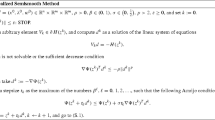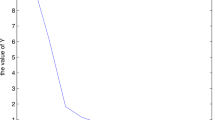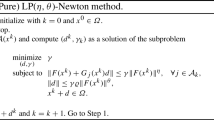Abstract
A variant of the Newton method for nonsmooth equations is applied to solve numerically quasivariational inequalities with monotone operators. For this purpose, we investigate the semismoothness of a certain locally Lipschitz operator coming from the quasi-variational inequality, and analyse the generalized Jacobian of this operator to ensure local convergence of the method. A simplified variant of this approach, applicable to implicit complementarity problems, is also studied. Small test examples have been computed.
Similar content being viewed by others
References
C. Baiocchi and A. Capelo,Variational and Quasi-Variational Inequalities. Applications to Free Boundary Problems, Wiley: New York, 1984.
B. Bank, J. Guddat, D. Klatte, B. Kummer and K. Tammer,Non-Linear Parametric Optimization, Akademie-Verlag: Berlin, 1982.
A. Bensoussan and J.J. Lions, “Contrôle impulsionnel et inéquations quasi-variationneles dévolution”,C. R. Acad. Sci. Paris, Sr. A 276, pp. 1333–1338, 1973.
D. Chan and J.S. Pang, “The generalized quasi-variational problem”,Math. Oper. Res. vol. 7, pp. 211–222, 1982.
F.H. Clarke,Optimization and Nonsmooth Analysis, Wiley: New York, 1983.
B.C. Eaves, “On the basic theorem of complementarity”,Math. Prog., vol. 1, pp. 68–75, 1971.
M. Fiedler,Special Matrices and their Application in Numerical Mathematics (in Czech), SNTL: Prague, 1981.
P.T. Harker and J.S. Pang, “Finite-dimensional variational inequality and nonlinear complementarity problems: A survey of theory, algorithms and applications”,Math. Prog., vol. 48, pp. 161–220, 1990.
P.T. Harker, “Generalized Nash games and quasi-variational inequalities”,European J. Oper. Res., vol. 54, pp. 81–94, 1991.
J. Haslinger and P. Neittaanm″aki,Finite Element Approximation for Optimal Shape Design: Theory and Application, Wiley: Chichester, 1988.
T. Ichiishi,Game Theory for Economic Analysis, Acad. Press: New York, 1983.
B. Kummer, “Newton's method based on generalized derivatives for nonsmooth functions: Convergence analysis”, in Proc. 6th French-German Colloquium on Optimization, Lambrecht, FRG, 1991,Lecture Notes in Economics and Mathematical Systems vol. 382, Springer: Berlin, 1992, pp. 171–194.
J. Kyparisis, “Solution differentiability for variational inequalities”,Math. Prog., vol. 48, pp. 285–301, 1990.
J. Kyparisis and Ch. M. Ip, “Solution behavior for parametric implicit complementarity problems”,Math. Prog., vol. 56, pp. 65–70, 1992.
U. Mosco, “Implicit variational problems and quasi-variational inequalities”, in Proc. Summer School, “Nonlinear Operators and the Calculus of Variations”, Bruxelles, Belgium, 1975,Lecture Notes in Mathematics vol. 543, Springer: Berlin, 1976, pp. 83–156.
J.V. Outrata, “On optimization problems with variational inequality constraints”,SIAM J. Optim. vol. 4, pp. 340–357, 1994.
J.V. Outrata and J. Zowe, “A numerical approach to optimization problems with variational inequality constraints”, accepted inMath. Prog.
J.S. Pang, “The implicit complementarity problem”, in Proc. Symp. on Nonlinear Programming, Madison, Wisc., 1980, Academic Press: New York, 1981, pp. 487–518.
J.S. Pang, “Newton's method forB-differentiable equations”,Math. Oper. Res., vol. 15, pp. 311–341, 1990.
Liqun Qi, “Convergence analysis of some algorithms for solving nonsmooth equations”,Math. Oper. Res., vol. 18, pp. 227–244, 1993.
Liqun Qi and Jie Sun, “A nonsmooth version of Newton's method”,Math. Prog., vol. 58, pp. 353–367, 1993.
S.M. Robinson, “Strongly regular generalized equations”,Math. Oper. Res., vol. 5, pp. 43–62, 1980.
S.M. Robinson, “An implicit-function theorem for a class of nonsmooth functions”,Math. Oper. Res., vol. 16, pp. 282–309, 1991.
K. Schittkowski, “NLPQL: A Fortran subroutine solving constrained nonlinear programming problems”,Annals Oper. Res., vol. 5, pp. 485–500, 1985.
H. Schramm and J. Zowe, “A version of the bundle idea for minimizing a nonsmooth function: Conceptual idea, convergence analysis, numerical results”,SIAM J. Optim., vol. 2, pp. 121–152, 1992.
M.J. Smith, “A decent algorithm for solving monotone variational inequalities and monotone complementarity problems”,J. Optim. Theory and Appl., vol. 44, pp. 485–496, 1984.
Author information
Authors and Affiliations
Additional information
This work has been supported in parts by a grant from the German Scientific Foundation and by a grant from the Czech Academy of Sciences.
Rights and permissions
About this article
Cite this article
Outrata, J.V., Zowe, J. A Newton method for a class of quasi-variational inequalities. Comput Optim Applic 4, 5–21 (1995). https://doi.org/10.1007/BF01299156
Received:
Revised:
Issue Date:
DOI: https://doi.org/10.1007/BF01299156




